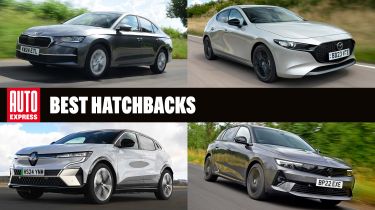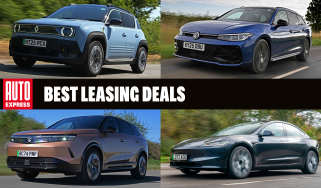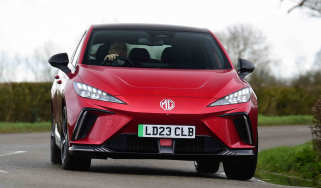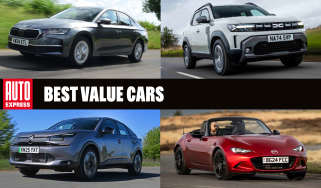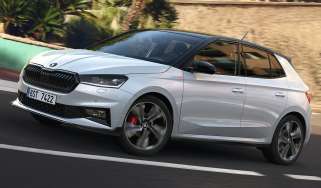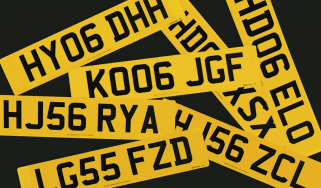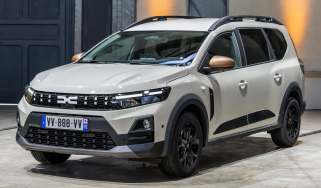Best hatchbacks to buy 2025
We’ve selected the top 10 best hatchbacks so you don’t have to
SUVs may currently rule the roads, but the humble family hatchback refuses to be overshadowed.
Once the go-to choice for families, the hatchback segment that has given us famous names like the Ford Focus and Volkswagen Golf has seen its popularity dwindle slightly. The best Hatchbacks are still some of the most tempting models on the current market.
Modern hatchbacks combine class-leading tech, comfortable interiors and stylish designs, making them appealing options for a wide range of buyers.
Our expert road testers drive and rate every new hatchback in the context of its rival models to build a full picture of how they compare. Each car is judged on practicality, efficiency, ease of driving and affordability, while also considering comfort, running costs and Euro NCAP safety ratings, and you’ll find the best hatchbacks to buy right here.
Compare the best hatchbacks
| Best hatchback Ranking | Name | Prices from |
Overall rating (out of 5) | Max. WLTP combined efficiency |
| 1 | Skoda Octavia | £28,000 | 4.5 | 65.7mpg |
| 2 | Honda Civic | £33,800 | 4 | 60.1mpg |
| 3 | Renault Megane | £31,000 | 4 | 285 miles |
| 4 | MG4 | £27,300 | 4.5 | 329 miles |
| 5 | Toyota Corolla | £30,800 | 4 | 64.1mpg |
| 6 | Citroen C4 | £23,100 | 4 | 50.7mpg/3.72mi/kWh |
| 7 | Audi A3 | £30,300 | 4 | 58.3mpg |
| 8 | Vauxhall Astra | £25,200 | 4 | 58.8mpg/4.09mi/kWh |
| 9 | Ford Focus | £28,700 | 4.5 | 53.3mpg |
| 10 | Mazda 3 | £25,000 | 4 | 47.9mpg |
Keep reading to see the best hatchbacks you can buy, according to our expert road testers. You can also jump directly to an individual model by clicking the links in the table above
1. Skoda Octavia
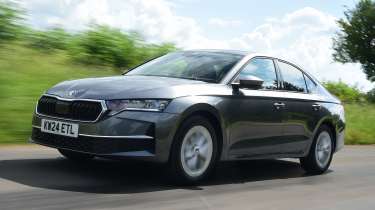
- Prices from £28,000
Pros |
Cons |
|
|
It’s hard to define the true best car on sale, yet few offer so much for so little as the Skoda Octavia. Our Auto Express Family Car of the Year for 2025, Skoda’s saloon-hatch hybrid embodies all the key qualities which the Czech firm stands for: value for money, quality and practicality, plus a great all-round ownership experience.
Since its debut in the mid-nineties, the Skoda Octavia has been one of the go-to choices for family car buyers who prioritise space and value. Over the years, it has moved upmarket in build quality, technology and price, but its core strengths remain.
With a starting price of around £28,000, nothing in the segment matches the Octavia’s sheer space. Rear passengers get more legroom than in any rival, while the 600-litre boot comfortably leads the class. Opt for the estate version and that expands to a cavernous 640 litres.
Despite being a long car at 4.7 meters, it’s easy to pilot around town with great all-round visibility. Erring on the side of comfort rather than sportiness – so long as you don’t choose the top-of-the-range vRS model – the Octavia feels refined on the move, with supple suspension, low wind noise and a range of quiet, perky engines.
It’s the Octavia’s interior which really puts the cat amongst the pigeons, however, both in the case of fit-and-finish, as well as available space. Arguably, the Octavia feels posher inside than the Volkswagen Golf with which it shares its underpinnings, with plenty of standard equipment making the cheaper Skoda look like a bargain in comparison. What we truly love, however, is all of the so-called ‘Simply Clever’ features dotted around the cabin, whether that be the hidden umbrella in the driver’s door, a parking ticket holder, or an ice scraper hidden away in the fuel filler cap.
"The Octavia is a big car for the class and most of that extra bodywork is hanging out the back, which means positioning the rear in a tight parking space requires a touch more care than in some rivals." - Alex Ingram, chief reviewer.
The Skoda Octavia has plenty of competitors on the market including the Volkswagen Golf, SEAT Leon, Mazda 3 or Toyota Corolla but it beats all of them for space
2. Honda Civic
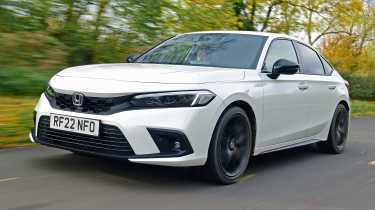
- Prices from £33,800
Pros |
Cons |
|
|
The Honda Civic is a great choice if you’re looking for sporty driving manners but don’t want to compromise on efficiency. With aggressive styling that isn’t skin-deep, it’s perhaps one of the most enjoyable cars to drive in this class, with a great chassis, good grip and decent power from its 2.0-litre hybrid powertrain.
Despite having a not-insignificant 181bhp and reaching 0-62mph in less than eight seconds, Civic buyers can also expect fuel economy in excess of 50mpg – we even achieved this in our real-world testing. This should help offset the car’s rather lofty starting price.
The Civic also has a stylish and spacious cabin that is perfect for everyday life, offering plenty of legroom for both adults and children. The 410-litre boot is also above average for the class, so there’s lots of space for luggage, too. The Civic’s driver-focused and well-built cabin is another strong point. However, a recent update has made this even better with the arrival of a fully-digital cockpit for the mid-spec Sport model (previously exclusive to top-spec cars), and a cosier black roof lining.
“The Civic’s sloping roofline won’t quite match the versatility of some of the boxier, more upright hatchbacks out there, but it’s practical enough for most needs.” - Ellis Hyde, news reporter.
The most obvious Civic alternative for those in the market for a Japanese hybrid hatchback is the Toyota Corolla, and this model also comes with the option of an estate variant
3. Renault Megane
- Prices from £31,000
Pros |
Cons |
|
|
The Renault Megane has been around for three decades, and while it has adopted some SUV traits in its transition to electric power, it hasn’t strayed far from its hatchback roots.
The Renault Megane is only available with the option of a 60kWh battery, which can return up to 285 miles on a WLTP efficiency combined cycle. This should be plenty if you mainly drive in urban areas, with the occasional long distance trip. When you do need to stop and charge, you can top-up from 15-80 per cent in around 32 minutes when using a 150kw fast charger.
Step inside and you’ll be greeted with the Megane’s greatest advantages and drawbacks. Getting the bad stuff out of the way first, looking through a letterbox would probably give you more visibility than the Megane’s rear window, while the back seats are a tad tight. However we cannot understate how fantastic the Megane’s Google-based infotainment system is. The boot is generous at 440 litres and there’s a useful charging cable storage space under the floor.
“EVs haven’t really embraced towing, but the Megane E-Tech is able to haul up to 900kg.” - Alex Ingram, chief reviewer.
If you’re tempted by the Megane but need something a bit larger, the Renault Scenic is a more family-friendly alternative based on the same platform for those who need more space in the rear seats and boot
4. MG4
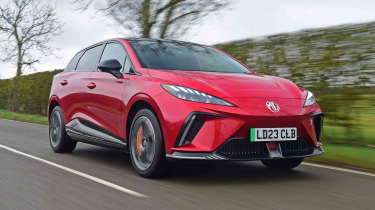
- Prices from £27,300
Pros |
Cons |
|
|
The MG4’s punchy starting price made headlines when it first arrived, and this former Auto Express New Car Award winner is still great value for money.
Base SE models begin at just over £27,000 and have a 218-mile range. The Long Range version extends this by 63 miles, all the while keeping the price below £30,000. Still not enough? The Extended Range car is officially capable of 329 miles before needing to be plugged in.
The MG4 is well-suited to life in and around town. Its electric powertrain means it’s very quiet and composed, and the regenerative braking system isn’t intrusive when you let off the throttle. Forward and rear visibility is also good, and the light, direct steering makes navigating tight spaces easy. Up the speeds on twisty roads and the MG4 is an engaging car to drive.
Sure, the infotainment system is basic and the cabin materials aren’t as premium as some rivals, but there’s plenty of space. The low roofline doesn’t eat into passenger headroom but the boot space is a little on the smaller side at 289 litres.
“The exterior of the MG4 will polarise opinion, but its sharp, dramatic lines, angular headlights and twin aero rear spoiler (on Trophy and XPower versions) mean it won’t get lost in the crowd.” - Ellis Hyde, news reporter, who drove the MG4 in the UK.
If you’re looking at an MG4 then electric hatchback rivals like the Kia Niro EV, Volkswagen ID.3 or Renault Megane will also appeal
5. Toyota Corolla

- Prices from £30,800
Pros |
Cons |
|
|
The latest Toyota Corolla is better than ever and available with two engine configurations. For the best fuel economy, the entry-level 1.8-litre 138bhp hybrid set-up is the one to get as this will, according to Toyota, return over 64mpg.
While it’s not as engaging to drive as a Volkswagen Golf or Ford Focus, the Corolla shines on long journeys, thanks to a refined ride and minimal road noise. Visibility is hampered slightly at the rear due the narrow rear window, but the reversing camera and parking sensors help when backing up.
The boot is only 361 litres, shrinking to 313 litres if you opt for the 2.0-litre engine, so rivals like the Honda Civic or Volkswagen Golf would be better if you need a larger boot. If you need more space, the Corolla is also available as an estate.
Inside, the Corolla doesn’t look as striking as it does outside, but everything feels suitably premium, and a mid-life update brought a new, easy-to-use infotainment system.
“The Corolla range lacks the plug-in hybrid technology offered in its rivals, but Toyota’s faithful ‘self-charging’ hybrid running gear continues to promise lower running costs compared to the traditional petrol hatchbacks” - Ellis Hyde, news reporter.
Two other household names act as the Toyota Corolla’s key alternatives, and these are the Volkswagen Golf and Vauxhall Astra — both of which come in hatchback and estate forms
6. Citroen C4
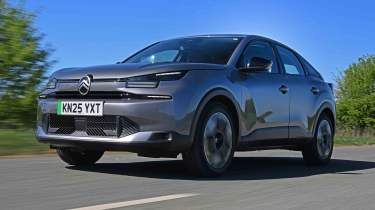
- Prices from £23,100
Pros |
Cons |
|
|
The Citroen C4 flies under the radar in the family car segment, yet it offers a refreshing alternative to more conventional hatchbacks.
Unlike many rivals that chase sportiness, the C4 prioritises comfort. Big wheels and stiff suspension are nowhere to be found. Instead, a supple ride and sofa-like seats deliver a plush, relaxed driving experience, aided by the high seating position.
The C4 majors on comfort, with soft seats and ‘hydraulic cushion’ bump stops in the suspension to iron out the harshness of any potholes you might encounter. While the petrol engine is quite rough, the all-electric Citroen e-C4 (with a range of up to 257 miles) is quiet, with the smoothness of an EV pairing nicely with the car’s cosseting nature.
The C4 makes for a great family car thanks to its spacious cabin. Taller passengers shouldn’t feel cramped thanks to the generous amounts of leg and headroom, which are even better than you’ll find in the likes of the VW Golf. All variants have 380 litres of boot space. The interior fit and finish is adequate, although it does feel below the standard of the best hatchbacks.
“I think the Citroen C4 receives plus points for continuing to use physical dials to operate the heating and air conditioning functions.” - Alastair Crooks, senior news reporter.
Very few cars can top the Citroen C4 in the comfort stakes, but if you want something a bit more practical, there’s also the Citroen C4 X and e-C4 X to consider
7. Audi A3
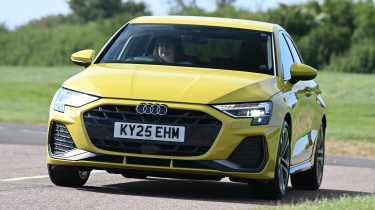
- Prices from £30,300
Pros |
Cons |
|
|
The Audi A3 is more than worthy of the four rings on its bonnet given its sophisticated driving manners, strong tech and high-quality interior, with all cars featuring Audi’s superb Virtual Cockpit digital instrument cluster which is partnered with a slick central infotainment touchscreen.
The latest A3 is a pretty common sight on the UK’s best-selling car list, so it’s clear that this blend of big car plushness and small car stature is striking a chord with buyers. Underneath the bonnet lies the choice between petrol, diesel or plug-in hybrid power, so there’s pretty much an A3 powertrain to suit every need. We’re fans of the 1.5-litre petrol which blends performance and efficiency, as well as the ultra-efficient PHEV with its 88-mile electric range.
If you opt for the plug-in hybrid, you will have to shave 100 litres off the A3’s 380-litre boot capacity. Fortunately, four adult passengers can get nice and comfortable in every A3 variant. If you need to tow, the diesel model can lug up to 1,600kg.
Wearing those four rings means the A3’s interior needs to truly stand out, and we’re pleased to report that it does. A mid-life facelift brought the overall quality up to an excellent standard, and there’s plenty of proper buttons to be found — unlike in the closely-related Volkswagen Golf.
“While the high-performance S3 and RS 3 deliver serious thrills, most drivers will find the lower-powered petrol, diesel, and hybrid A3 models more than competent for day-to-day driving.” - Alastair Crooks, senior news reporter.
As with any Audi, the A3 has to contend with direct competition from Mercedes and BMW. The Mercedes A-Class and BMW 1 Series are two other premium hatchbacks for similar money
8. Vauxhall Astra
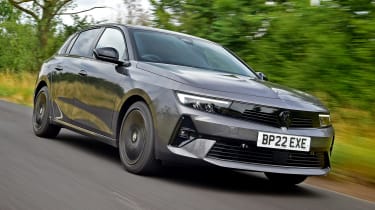
- Prices from £25,200
Pros |
Cons |
|
|
The Vauxhall Astra was never a particularly ugly thing, just a bit unexciting. This latest generation, however, changes all of that with a striking design courtesy of the brand’s signature ‘Vizor’ front end.
As with the related Peugeot 308, buyers of the Astra can choose from petrol, plug-in hybrid and fully electric powertrains. The former is the cheapest by far, and the base 1.2-litre turbo petrol engine’s 128bhp is fine for motorway use. Despite not being the fastest car out there, even in hybrid GSE form, the Astra is pretty handy to drive, with sharp steering and solid body control.
The Astra also undercuts the Peugeot on price. Don’t expect to be short changed, either as the Astra comes with plenty of standard equipment. The sharp design continues inside, where the traditional dials have been replaced by a modern cockpit with two 10-inch digital displays.
The Astra performs well as a family car thanks to the generous amounts of storage and a 422 litre boot, easily outclassing the Ford Focus which only has 375 litres. Things aren’t so great when it comes to rear passenger space, which can feel a touch cramped if you’re on the taller side.
“Stylish looks, impressive technology, and a wide variety of engines make the Vauxhall Astra a convincingly good family hatchback” - Ellis Hyde, news reporter.
The Ford Focus was the Astra’s main rival for decades, but this car’s time is almost up. The Peugeot 308 or Volkswagen Golf are also worth considering
9. Ford Focus
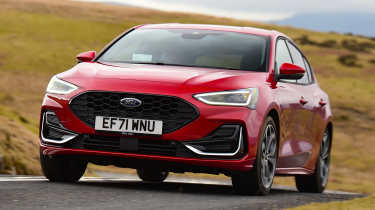
- Prices from £28,700
Pros |
Cons |
|
|
If driving fun is a priority, the Ford Focus should be at the top of your hatchback list – you’ll also need to act fast because production ends in November 2025.
The main reason to buy the Focus is for the way it drives, both in terms of its handling and its powertrain. For anyone who has spent any time in a Ford of recent years, the Focus has that same sharp and direct steering feel as other models in the line-up, while the range of EcoBoost engines are incredibly potent given their diminutive size.
The biggest flaw of the previous model was its cramped interior, but while the latest Focus’ styling has divided opinion, its longer wheelbase means passenger space is much improved. There’s now room for four adults, and a big 375 litre boot makes this a more practical family car, although you can get more boot space elsewhere in the class.
“The Ford Focus is a great-handling family hatchback that matches its rivals on interior quality and cabin space” - Ellis Hyde, news reporter.
The Focus has a long-standing rivalry with the Vauxhall Astra, which is better than ever in its latest guise. Other traditional hatchback rivals include the VW Golf, Kia Ceed and SEAT Leon
10. Mazda 3
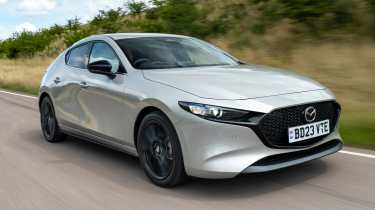
- Prices from £25,000
Pros |
Cons |
|
|
Stylish and dynamic in equal measure, the Mazda 3 is a great left-field choice; in true Mazda fashion, it blends a rewarding drive with unique design and impressive build quality.
Power comes from a choice of 2.0-litre petrol engines with either 120bhp or 184bhp, depending on trim. Both are responsive, while also returning decent fuel efficiency of more than 50mpg – a good thing because there’s no hybrid or EV. The 3 is also fun to drive, while the suspension does a pretty good job of soaking up the bumps and we love how direct the steering is.
Inside, the upmarket interior is among the best in the class, with a sleek design and solid materials. Apple CarPlay and Android Auto connectivity are standard, and the intuitive infotainment system is operated via a rotary dial, similar to BMW’s iDrive set-up. The sloping roofline does eat into rear headspace a little, and the boot isn’t the largest in class at only 351 litres.
“Build quality is great and the materials used are top-notch, especially on higher-spec models – there’s very little to complain about inside the 3’s cabin.” - Max Adams, online reviews editor.
If you’re interested in the Mazda 3, then you should consider rivals like the Honda Civic or more upmarket options like the Audi A3 or BMW 1 Series.
How to choose the best hatchback for you
Like skinny jeans, family hatchbacks were popular throughout the noughties and early 2010s. However, tastes have changed and buyers are now after something more fashionable with a little more space.
In the case of the automotive industry, our shift towards SUVs means many manufacturers have ditched their long-running hatchback name plates in favour of more desirable and, perhaps more importantly, profitable crossovers. That said, a few truly great hatches remain on the market for those who value simplicity and low running costs more than a loftier ride height.
With powertrain options ranging from fuel-sipping petrols to full EVs, plus hybrids sitting somewhere between, the relatively condensed size of a hatchback means it should, in theory, cost less to run than a bigger, bulkier SUV. That’s not to mention the thousands of pounds less you’ll be paying when it comes to the car’s list price compared with the aforementioned sports utility vehicles.
Yet despite this difference in size, most family hatches live up to their names by offering enough space for family life. While those with more than two children are probably better off looking at a people carrier or larger SUV, hatchbacks provide enough space for most with a much more accessible boot opening in comparison to something like a saloon.
Sitting lower than SUVs also means that hatchbacks can be a hoot to drive. We’re not just talking about hot hatches here, either; some of the best-driving family cars you can buy are of this body style, with compact dimensions, low kerbweights and punchy engines leading to a more enjoyable driving experience than you might expect.
How we choose the best hatchbacks
We don’t just take a manufacturer’s word for it when deciding what makes a great hatchback. We listen to the people who really matter, UK motorists!
Our exclusive survey of over 400 readers confirmed that buyers in the hatchback market are a demanding bunch, looking for a wider range of different capabilities than buyers in any other market sector.
- 63.5 per cent named reliability as a priority
- 54.1 per cent identified value for money
- 51.4 per cent chose running costs
- 48.6 per cent prioritised comfort
- 41 per cent prioritised ride and handling
- Technology was the lowest priority, but 20.3 per cent still identified it as a priority
Our expert road testers also put each car through its paces in the real world, focusing on what we know actually matters to buyers. A hatchback might look good on paper, but if it doesn’t hold up in everyday driving, it won’t make the cut.
1. Practicality
Practicality is key for any family hatchback, so we go beyond just looking at boot sizes and spec sheets. We check how easy it is to load, whether the seats fold flat plus how well the cabin works for real passengers – not just the tape measure. A car might have plenty of space, but if awkward door openings or cheap-feeling controls make life harder, it’s not doing its job properly.
2. Driving experience
A hatchback should be easy to drive, whether you're darting through city streets or settling in for a long motorway cruise. We test how it steers, how it rides over bumps and how it copes when fully loaded with people and luggage. Some hatchbacks manage to be both comfortable and fun to drive, and these are the ones that stand out.
3. Running costs
Fuel economy or MPG is another major factor, but we don’t just go by the official figures. We test these cars in real conditions to see how efficient they actually are. Running costs matter, too, factors such as servicing, insurance and even how much a full charge will set you back if you’re driving an EV are all evaluated.
4. Safety
A high Euro NCAP rating is a good starting point, but we also look at braking performance, visibility and how well the driver-assistance systems work. If the lane-keeping tech is too aggressive or the emergency braking system is overly sensitive, we’ll notice.
By putting every hatchback through the same tough testing, we make sure our recommendations aren’t just decided on numbers - they’re based on our own experience.
Brief history of the hatchback
The modern hatchback emerged in the 1970s, blending the practicality of an estate with a sportier, sloping rear design. Early pioneers like the Renault 4 and Fiat 127 led the way, and by the 1980s, the design became a staple for mainstream models like the Ford Escort.
Today, the hatchback is a truly versatile design found everywhere from compact city cars to powerful performance models like the Volkswagen Golf GTI. The signature top-hinged tailgate has even spread to larger, more luxurious vehicles like the Audi A7 Sportback and many SUVs, proving its enduring appeal.
It's a design that offers both practicality and style, which is why it continues to be a go-to choice in the compact family car class—the segment where you'll find icons like the Ford Focus, Honda Civic, and BMW 1 Series.
The hatchback tailgate arrangement is, of course, common across the car market these days in everything from SUVs to executive cars but the family hatches we’re focusing on here are the C-segment models that sit between B-segment superminis like the Renault Clio and D-segment family cars like the Volkswagen Passat size-wise.
Despite their compact dimensions, family hatchbacks are surprisingly versatile. Unlike traditional saloons, which have a separate boot, hatchbacks feature a wide-opening tailgate that makes loading and unloading items into the boot much easier, especially when carrying bulky items like suitcases or pushchairs. It’s also simple to fold the rear seats down to increase carrying capacity.
Smaller stature means that driving is much easier compared with a bulky SUV or full-size estate car. A lower ride height also means less of a climb in or out than in an SUV. At the same time, hatchbacks tend to feel more stable on the road than SUVs, with a lower centre of gravity that improves handling and agility.
Petrol, hybrid and diesel hatchback remain widely available, although the number of hatchbacks offered with a diesel engine are shrinking. There are an increasing number of manufacturers which now offer all-electric hatchback options, giving customers more choice than ever before.
Our dealer network has 1,000s of great value new cars in stock and available now right across the UK. Find your new car…
Best hatchback deals

